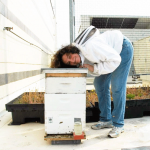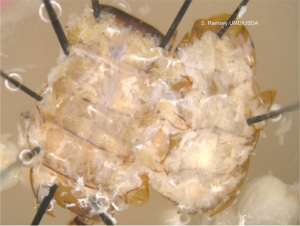Samuel Ramsey
 One thing you might hear about Samuel Ramsey, soon-to-be-Ph.D from the University of Maryland, is that he is a great speaker: during one talk, he proved that hungry ladybugs can bite by letting one chomp his arm. He won the international Three Minute Thesis Competition, beating over 1,000 other brilliant young scientists.
One thing you might hear about Samuel Ramsey, soon-to-be-Ph.D from the University of Maryland, is that he is a great speaker: during one talk, he proved that hungry ladybugs can bite by letting one chomp his arm. He won the international Three Minute Thesis Competition, beating over 1,000 other brilliant young scientists.
But this is what you really should know about the future Dr. Samuel Ramsey: his work represents one of those potential, “change everything” moments for which we have been longing since Varroa destructor began its relentless siege of honey bees.
To quote Sammy: “We’ve been thinking of these parasites as vampires when they’re actually more like werewolves. Maybe we’ve had so little success in killing them because we’ve been trying to drive a stake through something for which we needed a silver bullet.”
Ramsey’s work indicates that Varroa do not ingest hemolymph – the “blood”– of honey bees. They attack fat body tissue, an organ responsible for essential functions related to storing and releasing energy that the bee needs. We have been laboring under a critical misunderstanding of the most basic interaction between bees and the existential threat of over 40 years.
How is it to change received knowledge and be greeted with excitement?
“One concern is that when you tell people that something which they have believed for a long time is incorrect, often there is a tendency to get defensive, to feel offended that you would challenge things that way. It has been great to see that this really hasn’t gored anyone’s ox. People are seeing that the foundation of the earlier conclusion was not very sturdy.”
Was it actually explored? Did someone do an experiment with erroneous results?
Multiple studies were conducted in Russia in the 1970s and 80s. Remember, Varroa destructor is from Southeast Asia: when it started increasing its geographic range, it moved through China into Russia, the first areas to be hit hard. Therefore, much of the earliest research is written in Cyrillic [which already presents an obstacle]. The studies at the time used a method which was then considered OK, but which is not up to current standards. Researchers used strontium isotopes and some other things that we tend not to use for these experiments because they don’t stay in the tissues where they are supposed to be!”
“They were not measuring what they thought that they were measuring. Another of the problems that came across was translation, as well.”
“Using these problematic results, they stated ‘Varroa are feeding on hemolymph.’ Many saw only that statement. When a paper is written in a language that isn’t translated into English often, sometimes the abstract [only] is translated: this particular abstract did not include enough detail to tell that the methods used were not solid.”
“Using the abstract, people began to cite this paper, stating ‘Varroa are feeding on hemolymph.’ No one really questioned this until Dennis vanEngelsdorp, Allen Cohen, Jerry Hayes and I started discussing it in more detail.”
“Allen Cohen, an insect diet expert, was the one who said, ‘I don’t think that organisms with fast reproductive rates are able to get all the nutrition they need just from hemolymph.’ Hemolymph is mostly water.”
“Consider: Varroa produce an egg that is more than 33% of their body volume. The egg is HUGE, and she does it every single day. To be able to put that much biochemical energy into an offspring of that size, you need a lot of very potent nutrition which you can’t get from a source that is mostly water.”
“It also fails to account for the osmoregulatory burden – to explain: if you drink a lot of water, you can overwhelm your body’s ability to drain it, and your cells will grow and actually burst. They are not able to deal with the influx. Insects and arachnids that feed on things that are mostly water have special changes to their digestive systems to allow them to do so without exploding. Varroa does not have any of these changes. That was my observation.”
“Allen Cohen said, ‘Maybe they are feeding on the muscles? Maybe they are feeding on the fat body? They have to be feeding on something that isn’t hemolymph.’”
“That is what really got things going. Jerry Hayes had also thought of this, and mentioned it to Dennis vanEngelsdorp.”
Joining The UMD Lab.
“When I got to Dennis’ lab I was thinking, ‘If I am going to do a project now – it has to go somewhere. I don’t have time to start something and find that it doesn’t pan out.”
“I love work that’s on insect behavior, parasite behavior, predator behavior. I’m very interested in the behavior of organisms, how they get their food, etc. But that particular project sounded very risky, because it’s going to be a binomial answer: Yes or No. People have believed this for a long time, and they probably had good reason.”
“I started looking through the literature, and it didn’t look like anybody was questioning it! My concern was that everyone cited earlier papers that said ‘Varroa feeds on hemolymph,’ but no one cited the original. As a researcher, you are supposed to cite the source that information comes from, not someone quoting someone quoting someone…”
“I had to trace the chain back years and years. It took me months to find the original source. When I found it, I realized, ‘OK, there could be something here, because these methods don’t get you to the conclusion that everyone has been using.’”
It Was Personal.
“The part that often grabs people is that one reason for this project involves my Dad. I was considering three different projects, ‘Which one?’ I talked to my dad after only a small amount of research, and he said, ‘I don’t know what I am going to do about this gout thing. I don’t know what I can eat, what I can’t eat!’ It’s a painful joint problem he’d had for months: my dad would think that he’d figured it out, but would have another flare up.”
“Of course, he asks his scientist son for help to understand what gout is and how it causes problems. When I found that gout was related to purine crystals, a bell went off in my mind, “Wow, that’s weird! That’s what the Varroa mites use as their waste product!”
“I started trying to figure out the source of the problem with purine crystals in his blood, causing painful arthritic friction. What source is it that high in purines?” [note: purine is the name for the chemical group of which guanine is a part.]
“I thought, ‘If I can figure out what my dad should not be eating, I might be able to find out what these mites are eating.’ At the top of every list was Don’t Eat Liver. I thought, ‘Where is the bee’s liver?’ The equivalent in insects is the fat body. This is something Dr. Cohen had mentioned.”
“It’s hard to move forward by starting with a negative, ‘It’s not hemolymph.’ There are a lot of things that aren’t hemolymph. When the guanine, fat body connection arose, I was surprised and found a paper that discusses the functions of the fat body in some detail, and a ton of other papers looking at the fat body. It is a fascinating organ! I learned that the fat body is the organ that creates guanine in insects. Pieces started to fall together.”
“That’s the story of how things started, and I am glad for the opportunity to tell it, because it’s helpful for people to know that science moves along, building on other researchers. One: when you fail to cite the original paper, it can end up being like the Telephone Game. That can create problems itself, but it also prevents people from seeing the original methods used to come to those conclusions. Most researchers probably wouldn’t have continued citing that paper if they had seen the methods. But they were citing people that they trusted.”
“It is also important to remember that science works as a conglomerate, we work together. Working with Jerry, Dennis, Allen, the other coauthors, I moved questions forward, and decided how things would be structured, but I could not possibly have done this without Dr. Cohen, without Ronald Ochoa, Gary Bauchan, and Connor Gulbronson.”
Bee Fat, Not Bee Blood.
I’m excited about this project specifically because the pathologies that are associated with Varroa have been all over the place. When I first started studying Varroa, I was overwhelmed by the sheer amount of negative consequences that it causes – early onset foraging, reduced overwintering success, reduced lifespan, viral transmission, difficulties with metabolic functions, ability to navigate properly – all of this stuff! It seemed strange that all of this could be related to the removal of a small amount of hemolymph.”
“It also reminds us not to discount how clever and important Varroa is. I have presented to a lot of researchers and beekeepers, and with many beekeepers there has been a disconnect. Researchers say, ‘Yes, Varroa are very important creatures, reducing their populations is of the utmost importance.’ But beekeepers will often say, “Oh, that’s the lowest on my list. I never see Varroa in my colonies, if I see them it’s just a couple. Not a big deal.’ My research has helped to show that you are unlikely to see them, because the places where they are most likely to be are always going to be hidden if your bees are at any kind of natural standing or flying position. The image that we have of the mite conspicuously on the bee’s thorax is misleading because they spend so little of their lifecycle there. These [results] have been helpful, because when I explain this to beekeepers now, they say, ‘Why have I never heard this before?! I had no idea.’ It has helped people see that there is an important utility to tests and monitoring for mites aside from just opening colonies and looking.”
“It also makes the point that it is important to keep these populations low, because they perforate the liver of a bee. If I had a parasite on me that was the size of my hand, that was sucking out parts of my liver, there is just no way that I would let that go on!”
“It has helped these beekeepers understand, ‘I’ve gotta do something about this!’ It has created an imperative to do something to reduce the population of these parasites. What is exciting is to have beekeepers come up and say, ‘This [research] has changed the way I think about beekeeping.’ Some of them have been keeping bees for years, for decades. I am a young guy, it is cool to hear people say that some work I have accomplished has helped change the paradigm on something they have been doing for decades.”
Is Varroa Resistance Possible?
“When talking about breeding for resistant stock, I ask people to think about a ‘genetic arms race” or an ‘evolutionary arms race.’”
“People often use the term when talking about antibiotic resistance. Antibiotic resistance works like this: we have a weapon, a drug, and we want to use it to kill the bacterium. But the bacteria have very short generation [reproduction] times. They can reproduce very, very quickly, and in a day you can have hundreds of generations that have grown and divided, and it is crazy how quickly some of them can. [Like] an arms race, every time they mate and produce new offspring, there are choosing new weapons and new defenses to block the old antibiotics. Therefore, we need to constantly use new forms of antibiotics to treat these bacteria.”
With Varroa, this time we have two different organisms facing off. It’s not a drug, it’s a bee that we are trying to breed to have a resistance to this mite. While the bee can get a leg up, the mite can get a leg up, too. One problem is that the bee’s generation time is MUCH longer than the mite’s. If we think of this as an arms race, every time that bee gets the chance to choose one weapon to use against Varroa, the mite has the opportunity to choose several.”
“Over the course of a year, Varroa destructor may have nine generations, sometimes 12 or 14. That’s a lot of weapons that they get to choose. The bee? Maybe one, just one opportunity to [mate and] create a new set of offspring. Sometimes we even stop that from happening: when we stop swarming from happening, stop the colony from splitting, you don’t even have that opportunity for new genetic stock to present itself.”
“I am not one who believes [in a system where] people breed resistance in their own bees by letting the mite populations get really high, and that the best will survive, the other ones won’t – I don’t believe that it is a good method, because the mites have a head start, and too many opportunities to continue building upon their current progress. Systems that researchers are currently using in the lab [that speed up honey bee generation time] – seem promising in some ways. But I don’t think that it is a good idea to let your bees die in hopes that you will emerge with this new super bee. That is very unlikely. I think it takes a lot of work and genetic conditioning and time in the lab and generation time that won’t happen out in the field.”
“A good example is to look at what happened to the bees in the US. Within 10 years of the introduction of Varroa destructor, we’ve lost our feral honey bee colonies. Anything that wasn’t managed, died out. All the diversity that the bees had was not able to stand up to how quickly Varroa generation times are able to ratchet forward.”
“I don’t think that it is an option for us to let their [mite] populations spiral – I don’t think that the permanent answer is constantly treating for Varroa. The amount of chemical input into the colonies currently is unsustainable. I think while we are figuring out what the answer is, we have to continue reducing their populations. It is not an option to just let them run wild.”
“It is fair to say that breeding for survivor stock in the field is highly unlikely to yield a resistant bee because of the evolutionary arms race that is going on. In the field, we can’t help the bee replicate at that speed.”
In The Future.
“Options like RNA interference and approaches of that nature hold great potential to reduce the chemical input into the colonies. It won’t get rid of it entirely, because we do need to make sure that we vary the ways used to reduce the populations of Varroa to prevent resistance.”
“If we can introduce something that disrupts the reproductive cycle of the mites. They feed on the bees, they get sterilized, they go into a cell and try to produce offspring, and they don’t. They die.”
“Or perhaps an approach where, when the mites feed, it disrupts their ability to continue digesting their food. They stop feeding, they get sick, they die.”
“These kinds of things are exciting, but in some way they are still science fiction because they have not reached a point yet where they are ready to be introduced.”
“There is still the concern about the Law of Unintended Consequences when a particular technology is very new. We need to look at all of the different angles of how this could affect an organism before we introduce it into the market. At the moment I am ready to say that I am happy about the potential.”
Looking Forward.
“I’ve had the opportunity to work with a lot of different groups of people. I tend not to do just one thing – I sing, I love music, I am an entertainer – work on doing weddings with some people – I have worked with a lot of groups of people! I am very involved with my church . . .”
“One thing is that beekeepers are some of the most caring, amicable, pleasant people whom I have ever worked with. Beekeepers and bee researchers are a tight-knit group. There is an excitement around research in bees.”
“Few things make me more excited than seeing people who aren’t researchers being so interested in research. It takes a lot of work and a lot of trust to create that partnership that we are seeing. Things like the BeeInformed Partnership that help make sure that information is disseminated – also people like Randy Oliver. This is something that I have never seen before, a partnership between the researchers and people who are not, but who are so interested in their work.”
“I didn’t start out as a honey bee researcher: I researched predators and parasites and their behavior. When I started researching Varroa behavior I would think of myself as primarily a parasite researcher. But I have become so enamored of the beekeepers and the bee researchers and this incredible partnership! People talk all the time about how research rarely gets across to the people it needs to reach: they have not paid enough attention to the beekeepers and the bee researchers, because they are wonderful and now I am hooked! I am hooked!”
“I want to use my knowledge of honey bees and honey bee parasites to benefit the beekeeping community and the bee research community. This has changed the way that I think about my own career going forward. Now I want to do research on bees, and do as much research on bee parasites as I can!”

Find me online!
www.twitter.com/tonibee
www.citybees.blogshop.com
Toni Burnham keeps bees and helps new beekeepers get started in the DC area.








